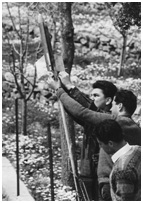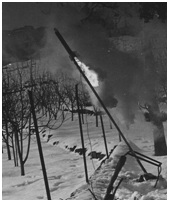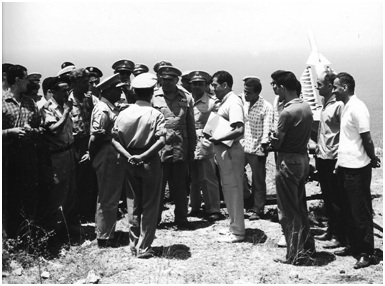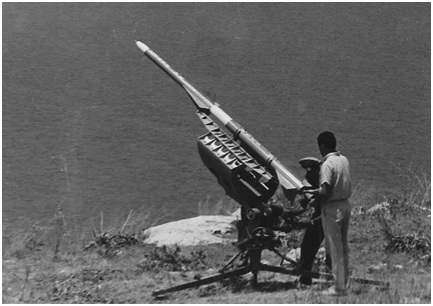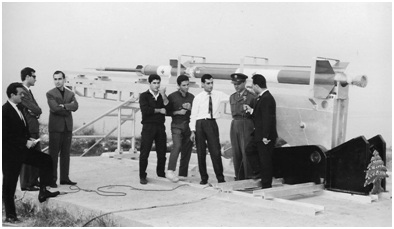You can read Part 2 at: http://www.chanitz.org/2011/03/rising-of-rocket-part-2.html
You can read Part 3 at: http://www.chanitz.org/2011/05/rising-of-rocket-part-3.html
The 1st Rockets Shot in the Middle East by a Small Lebanese-Armenian College
November 2010 marked the 50th Anniversary of Haigazian University’s Rocket Society. For this reason, I had a very interesting and empowering interview with Dr. Manoug Manougian – the man behind the creation of the Society and its dazzling achievements, and Mr. Hampar Karageozian – one of the brightest students of the Society and a holder of more than 30 patents in the field of pharmaceutics.
Note: The interview has been divided into 3 parts.
The Rising of a Rocket – Part 1
Mano Chilingirian: Dr. Manougian and Mr. Karageozian, can you give us a brief introduction about yourself? What you currently do, where you reside and what your interests are.
Dr. Manougian: I was born in the Old City of Jerusalem, and attended St. George’s School. In 1956, I received scholarships to study at the University of Texas at Austin. In 1960 I graduated with a B.A. in Mathematics and Physics, and returned to Jerusalem where I got married to Josette Masson. We have one son, Michael. From 1960 – 62 and 1964 – 1966 I was an Instructor/Assistant Professor at The Haigazian College. And from 1976 till this day I am a Professor of Mathematics at the University of South Florida (USF).
Honors and Awards
1. Outstanding Teaching Awards (1994, 1996, 1998, 2001, 2004)
2. Honorary Texas Citizen, awarded by Governor Price Daniel.
The Oxford Round Table at Oxford University, U.K.
- Member and invited speaker.
Educational Programs in Progress
1. I am helping to establish an Armenian Studies Center at USF. The first symposium titled “Rediscovering Armenia” was held October 29 – 31, 2010.
2. I am establishing a six-week summer program for gifted high school graduates to be held at the University of South Florida. Armenian students will be selected from the Middle East and Armenia. This will be an intensive program in mathematics, computer science, and environmental science. Students who complete the program successfully will receive college credit.
3. I am helping engineering students to form the USF Rocket Society. I will be their faculty advisor.
Mr. Karegeozian: I have been in the United States since 1966, I came as a graduate student to MIT and did graduate work in the area of Biochemistry.
In 1969 after graduation I left for California and have been in California ever since. I worked with Allergan Pharmaceuticals, Inc. for 23 years and became the youngest Vice President of the company, and became the Senior V.P of Research and Development. During my stay at Allergan the company started with $10 million, and when I took early retirement in 1992 the company had sales of $1.5 billion. Both my team and I were very instrumental in the great growth of the company because during this period of 23 years I had introduced about 70 new products, and had filed close to 30 patents on behalf of the company.
When I took early retirement I was still very young, so I was interested in starting my own company and repeat the success of what we had achieved with Allergan. Since then, I have started 5 new different companies, and most have been very successful; in addition, my quest for new ideas, new inventions with US and International patent applications have increased dramatically.
Presently I have created a new company named Allegro Ophthalmic, which is focused on solving issues related to blindness associated with Diabetes, Diabetic retinopathy, Wet Macular Degeneration and other related blinding diseases in the eye. We have very close connections with several universities which are very close geographically to us, including California Institute of Technology, University of California at Irvine, University of Colorado, and John Hopkins. My son who is a practicing ophthalmic surgeon as well as my daughter who is a Human Clinical study person work with my company, and we are in the middle of Human Clinical Phase 1 studies on these new compounds that we have discovered and are testing in humans.
I reside in South Orange County in a city called San Juan Capistrano, and I am 60 miles south of Los Angeles, and 60 miles north of San Diego, California.
Mano Chilingirian: In November 1960, a group of The Haigazian College students got together under the guidance of Manoug Manougian - a Math and Physics instructor - to form the Haigazian College Rocket Society (HCRS). What was the vision behind the founding of the Society? Who came up with the idea? What were the Society’s major obstacles?
Dr. Manougian: My passion for rocketry began at an early age when I was at St. George’s School in Jerusalem. My wooden desk was covered with carvings of rockets flying to the moon. After graduating from the University of Texas with a B.A. (1960) I joined the faculty at The Haigazian College as an instructor of mathematics and physics. I was assigned as faculty advisor for the Science Club. This provided me with the opportunity to realize the dream of rocketry. Thus, I renamed the Science club and formed the Haigazian College Rocket Society. Initially the student members were Simon Aprahamian, Garabed Basmadjian, Hampartsum Karageozian, Hrair Kelechian, and Michael Ladah. Others who joined were John Tilkian, Hrair Aintablian, Hriar Sahagian, Jirair Zenian and Jean Jack Guvlekjian.
The purpose of HCRS was two-fold: (a) teach my students the methods of science, and (b) encourage them to pursue careers in mathematics, engineering and science. I made it clear at the offset that the project was not for military purposes. Rather, it is a voyage in the science of Rocketry. Members of the Society met regularly where I discussed rocket design and the mathematics of flight.
The next step was to come up with a propellant. And we did. In view of the inherent dangers of propellants our first attempts were conducted away from the College on a farm belonging to Hrair Kelechian’s family. After a few mishaps we perfected a propellant and launched a small 45 cm long rocket.
Excitement at The Haigazian College ensued. Thus, in April 1961 we prepared a rocket that was 1.75 meters long and invited the entire student body to witness the launching. We selected KCHAG in the Ain Saade area for the launching. Although the rocket performed successfully reaching a height of about 1,000 meters, the primitive launcher directed the rocket in the opposite direction from what was planned. This prompted the Lebanese government to control the launching sites. In May 1961, a second similar rocket was then launched on Sannine that reached a height of about 2,300 meters.
Incidentally, it was not until July 1961 that Israel launched its first rocket. Thus, The Haigazian College and Lebanon were able to claim to be the first to have launched a rocket in the Middle East.
Mr. Karegeozian: In 1960 most of the students at the HCRS were freshman students when Manoug Manougian came [up] with the idea of starting a Rocket Society and it started from there. At the very beginning there was a lot of frustration, because everything that the students were intending to use involved some explosive chemicals that we could not purchase from the market. The government had very strict restrictions for the sale as well as the use of these chemicals. However, as the Society got involved with the Lebanese Military, the military was instrumental in getting us the chemicals that we needed to use as fuel for the various rockets that the HCRS was able to build. In addition the steel tubing that we needed to make the rocket body was not available. Again the Lebanese Army was very instrumental in making sure that we had access and in addition they x-rayed the tubes to ensure that there were no weak spots in the body of the rocket so as not to cause an explosion on the launching pad. And lastly, the nozzle configuration had to be well lath cut according to precise calculations that we did at HCRS, but the lath cutting had to be precisely done and again the Lebanese military was very instrumental in helping.
The Vision behind the formation of the HCRS started as a science project to make sure that the students had the motivation and the ability to get a very difficult area of science and work with it to raise interest in science. However, as the HCRS became more successful it became a focal point for other universities as well as to other institutions about the science as well as the prestige associated with this success.
H. Kelechian, M. Manougian, A 45 cm rocket.
H. Karaguezian The propellant worked
on Kelechian’s family farm:
You can read Part 3 at: http://www.chanitz.org/2011/05/rising-of-rocket-part-3.html
The 1st Rockets Shot in the Middle East by a Small Lebanese-Armenian College
November 2010 marked the 50th Anniversary of Haigazian University’s Rocket Society. For this reason, I had a very interesting and empowering interview with Dr. Manoug Manougian – the man behind the creation of the Society and its dazzling achievements, and Mr. Hampar Karageozian – one of the brightest students of the Society and a holder of more than 30 patents in the field of pharmaceutics.
Note: The interview has been divided into 3 parts.
The Rising of a Rocket – Part 1
Mano Chilingirian: Dr. Manougian and Mr. Karageozian, can you give us a brief introduction about yourself? What you currently do, where you reside and what your interests are.
Dr. Manougian: I was born in the Old City of Jerusalem, and attended St. George’s School. In 1956, I received scholarships to study at the University of Texas at Austin. In 1960 I graduated with a B.A. in Mathematics and Physics, and returned to Jerusalem where I got married to Josette Masson. We have one son, Michael. From 1960 – 62 and 1964 – 1966 I was an Instructor/Assistant Professor at The Haigazian College. And from 1976 till this day I am a Professor of Mathematics at the University of South Florida (USF).
Honors and Awards
1. Outstanding Teaching Awards (1994, 1996, 1998, 2001, 2004)
2. Honorary Texas Citizen, awarded by Governor Price Daniel.
The Oxford Round Table at Oxford University, U.K.
- Member and invited speaker.
Educational Programs in Progress
1. I am helping to establish an Armenian Studies Center at USF. The first symposium titled “Rediscovering Armenia” was held October 29 – 31, 2010.
2. I am establishing a six-week summer program for gifted high school graduates to be held at the University of South Florida. Armenian students will be selected from the Middle East and Armenia. This will be an intensive program in mathematics, computer science, and environmental science. Students who complete the program successfully will receive college credit.
3. I am helping engineering students to form the USF Rocket Society. I will be their faculty advisor.
Mr. Karegeozian: I have been in the United States since 1966, I came as a graduate student to MIT and did graduate work in the area of Biochemistry.
In 1969 after graduation I left for California and have been in California ever since. I worked with Allergan Pharmaceuticals, Inc. for 23 years and became the youngest Vice President of the company, and became the Senior V.P of Research and Development. During my stay at Allergan the company started with $10 million, and when I took early retirement in 1992 the company had sales of $1.5 billion. Both my team and I were very instrumental in the great growth of the company because during this period of 23 years I had introduced about 70 new products, and had filed close to 30 patents on behalf of the company.
When I took early retirement I was still very young, so I was interested in starting my own company and repeat the success of what we had achieved with Allergan. Since then, I have started 5 new different companies, and most have been very successful; in addition, my quest for new ideas, new inventions with US and International patent applications have increased dramatically.
Presently I have created a new company named Allegro Ophthalmic, which is focused on solving issues related to blindness associated with Diabetes, Diabetic retinopathy, Wet Macular Degeneration and other related blinding diseases in the eye. We have very close connections with several universities which are very close geographically to us, including California Institute of Technology, University of California at Irvine, University of Colorado, and John Hopkins. My son who is a practicing ophthalmic surgeon as well as my daughter who is a Human Clinical study person work with my company, and we are in the middle of Human Clinical Phase 1 studies on these new compounds that we have discovered and are testing in humans.
I reside in South Orange County in a city called San Juan Capistrano, and I am 60 miles south of Los Angeles, and 60 miles north of San Diego, California.
Mano Chilingirian: In November 1960, a group of The Haigazian College students got together under the guidance of Manoug Manougian - a Math and Physics instructor - to form the Haigazian College Rocket Society (HCRS). What was the vision behind the founding of the Society? Who came up with the idea? What were the Society’s major obstacles?
Dr. Manougian: My passion for rocketry began at an early age when I was at St. George’s School in Jerusalem. My wooden desk was covered with carvings of rockets flying to the moon. After graduating from the University of Texas with a B.A. (1960) I joined the faculty at The Haigazian College as an instructor of mathematics and physics. I was assigned as faculty advisor for the Science Club. This provided me with the opportunity to realize the dream of rocketry. Thus, I renamed the Science club and formed the Haigazian College Rocket Society. Initially the student members were Simon Aprahamian, Garabed Basmadjian, Hampartsum Karageozian, Hrair Kelechian, and Michael Ladah. Others who joined were John Tilkian, Hrair Aintablian, Hriar Sahagian, Jirair Zenian and Jean Jack Guvlekjian.
The purpose of HCRS was two-fold: (a) teach my students the methods of science, and (b) encourage them to pursue careers in mathematics, engineering and science. I made it clear at the offset that the project was not for military purposes. Rather, it is a voyage in the science of Rocketry. Members of the Society met regularly where I discussed rocket design and the mathematics of flight.
The next step was to come up with a propellant. And we did. In view of the inherent dangers of propellants our first attempts were conducted away from the College on a farm belonging to Hrair Kelechian’s family. After a few mishaps we perfected a propellant and launched a small 45 cm long rocket.
Excitement at The Haigazian College ensued. Thus, in April 1961 we prepared a rocket that was 1.75 meters long and invited the entire student body to witness the launching. We selected KCHAG in the Ain Saade area for the launching. Although the rocket performed successfully reaching a height of about 1,000 meters, the primitive launcher directed the rocket in the opposite direction from what was planned. This prompted the Lebanese government to control the launching sites. In May 1961, a second similar rocket was then launched on Sannine that reached a height of about 2,300 meters.
Incidentally, it was not until July 1961 that Israel launched its first rocket. Thus, The Haigazian College and Lebanon were able to claim to be the first to have launched a rocket in the Middle East.
Mr. Karegeozian: In 1960 most of the students at the HCRS were freshman students when Manoug Manougian came [up] with the idea of starting a Rocket Society and it started from there. At the very beginning there was a lot of frustration, because everything that the students were intending to use involved some explosive chemicals that we could not purchase from the market. The government had very strict restrictions for the sale as well as the use of these chemicals. However, as the Society got involved with the Lebanese Military, the military was instrumental in getting us the chemicals that we needed to use as fuel for the various rockets that the HCRS was able to build. In addition the steel tubing that we needed to make the rocket body was not available. Again the Lebanese Army was very instrumental in making sure that we had access and in addition they x-rayed the tubes to ensure that there were no weak spots in the body of the rocket so as not to cause an explosion on the launching pad. And lastly, the nozzle configuration had to be well lath cut according to precise calculations that we did at HCRS, but the lath cutting had to be precisely done and again the Lebanese military was very instrumental in helping.
The Vision behind the formation of the HCRS started as a science project to make sure that the students had the motivation and the ability to get a very difficult area of science and work with it to raise interest in science. However, as the HCRS became more successful it became a focal point for other universities as well as to other institutions about the science as well as the prestige associated with this success.
H. Kelechian, M. Manougian, A 45 cm rocket.
H. Karaguezian The propellant worked
on Kelechian’s family farm:
Mano Chilingirian: On May 25, 1962, HCRS-7 Cedar was launched up to 11 500 m, and the Lebanese Army was responsible for the security of the launch. In the summer of 1962, two more rockets, Cedar ll B and Cedar ll C, were launched to a distance of 20km. Due to the successes of the HCRS new members joined and a new group was formed in 1962 calling itself the Lebanese Rocket Society (LRS). What were the reasons behind the decision to expand the Society to include members from other universities?
Dr. Manougian: As a result of national interest in the study of rocketry, the Lebanese Rocket Society was formed. The supervising committee of the LRS consisted of: M. Manougian, Dr. P. Mourad (AUB), L. Karamanougian, Capt. J. Sfeir, E. Kai and Capt. J. Wehbe.
Mr. Karegeozian: I do not recall members of other universities becoming members of the HCRS. I do not recall also the HCRS being called as the Lebanese Rocket Society. I remember that in 1962 the Lebanese Military got more involved in the project, but throughout this project the students at HCRS were the key people who were running the group.
Manougian is addressing questions posed by Lebanese military officers (at Dbayeh)
Final inspection before launching the last of the Cedar 2 series (at Dbayeh)
Capt. Wehbe and Manougian
In my office with Capt. Wehbe
Cedar 3 moments before launch
Cedar 4 before launch




